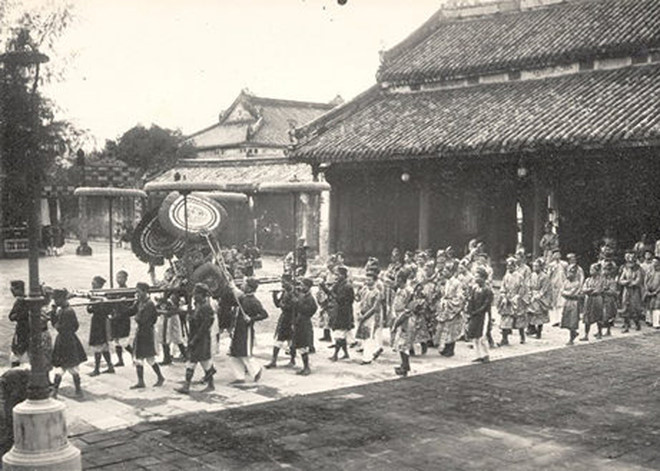The Tet celebrations in the royal palace and among the nobility have always intrigued many. Except for those who have been close to the royal family, everyone is curious about how Tet is celebrated in the imperial court.
The Nguyen Dynasty – the last feudal regime in Vietnam – has been dissolved for over half a century. However, many of the marks left by this dynasty still exist, including several monuments recognized as UNESCO cultural heritage, which encompass the customs and rituals of the emperor during Tet.
The Ban Soc Ceremony
According to the book “Tet Celebrations in the Nguyen Court,” every year, the Nguyen court begins the New Year celebrations with the Ban Soc ceremony, held on the first day of the twelfth lunar month at the Ngo Mon Pavilion.
Ban Soc means the office of the Khâm Thiên Giám, which prepares the calendar for the New Year and distributes the emperor’s calendar to the officials and royal family members. Those receiving the calendar wear formal attire and bow five times towards the throne placed in the Thai Hoa Palace to express gratitude to the emperor.

Tet Ceremony in the Nguyen Court. (Photo: Researcher Vo Tong Xuan).
Following the Ban Soc ceremony is the Phat Thuc ceremony, which involves cleaning and polishing the royal seals, gold seals, and ceremonial books. This ceremony is conducted at the Can Chanh Palace, where the national treasures are stored.
After the cleaning is completed, officials refer to last year’s inventory to take stock of all the treasures before sealing them tightly in their chests. After the Phat Thuc ceremony, the departments cease work to prepare for Tet.
On the 30th day of Tet, the Khâm Thiên Giám selects an auspicious time for the Ministry of Rites to erect the Tet pole. The Tet pole is also raised in the capital, localities, temples, and households. This marks the moment when the entire populace prepares to welcome Tet. The Tet pole signals the day when everyone takes a break to celebrate the New Year.
The Tet Nguyen Dan occurs on the first day of the lunar New Year. On that day, soldiers carry weapons, flags, and beautifully adorned elephants and horses, along with various types of vehicles usually used by the emperor, lined up in front of the Thai Hoa Palace extending out to the Ngo Mon Gate.
The emperor dresses in formal attire and proceeds from the Can Chanh Palace to the Thai Hoa Palace, where he sits on the throne to receive the bows and greetings from officials and royal family members. While the emperor is seated, the Ngo Mon Pavilion rings bells and drums sound continuously, creating a majestic atmosphere.
The emperor’s wives remain within the palace. Those in the inner sanctum and officials wear formal attire during Tet Nguyen Dan, standing in two honorific lines from the Can Thanh Palace to the Can Chanh Palace to greet the emperor as he passes by.
From the 30th day of Tet to the 3rd day of Tet, offerings are placed at various temples and the Phung Tien Palace, with incense smoke rising high. Each offering consists of 32 separate dishes such as spring rolls, roasted chicken, roasted pork, and goat meat. In the morning, offerings are made to the kings, and in the afternoon, to the national heroes. The offerings are prepared by the royal kitchen or brought from localities to the capital.
The Tich Dien Ceremony
In addition to the ceremonies in the royal palace, Tet also features the important Tich Dien ceremony, aimed at encouraging agricultural development. On this day, the emperor and royal family members descend to the fields to plow a few furrows, encouraging the people to engage in agriculture.
The emperor wears a traditional outfit, a ceremonial headscarf, and shoes, holding a whip in one hand and a gold-painted plow in the other, pulled by two oxen draped in golden silk. Accompanying the emperor are the Phu Doan of Thua Thien and an official from the Ministry of Finance, carrying seeds and fabric.
After plowing, the emperor sits on a raised platform to observe the royal family members and high-ranking officials continue plowing. This is merely a supportive activity. After the Tich Dien ceremony concludes, the designated area will be assigned to a responsible party, who is obligated to cultivate it for offerings at the Nam Giao altar and to various deities and shrines.
The ceremonies in the Imperial City and the Tich Dien plowing are organized within the royal family, with only a few high-ranking officials and select dignitaries present, while the general populace is not allowed to participate.
Granting “Fire of Affection” to the Concubines
During Tet, no wives or children are allowed to dine with the emperor. As a result, many women bear the title of the emperor’s wife but do not see him throughout the year, even though they live only a few dozen meters away from his residence.
To provide an opportunity for the concubines, consorts, and beautiful women of the nine ranks to see the emperor during the spring celebrations, the Nguyen emperors devised a unique way to meet.
On the winter solstice each year, all fires in the Forbidden City must be extinguished. The Can Thanh Palace ignites a large fire. At midnight, the women in the palace are allowed to bring their incubators to the Can Thanh Palace to receive some fire from the emperor, symbolizing the granting of warmth to everyone. This “fire of affection” will be carefully kept by the women throughout the year.
In ancient beliefs, the emperor is considered the “Son of Heaven,” wielding all power. For the emperors, Tet is not only a time to pause state affairs for leisure but also a time to inventory treasures (Phat Thuc ceremony), prepare for the upcoming year’s work, honor ancestors, and encourage the populace to engage in productive endeavors (Tich Dien ceremony).
The Nguyen Dynasty may no longer exist, but all these Tet activities can still be found in historical records and carry significant meanings. They are also part of our intangible heritage today.


















































